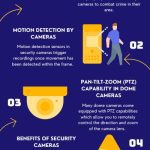Are you tired of worrying about the safety of your home when you’re away? Do you want to have the peace of mind of knowing that your family and possessions are protected?
With the rise of smart home security and devices, you can now take control of your home’s security like never before.
From smart locks and cameras to advanced sensors and alarms, these innovative technologies allow you to monitor your home from anywhere, at any time.
So, Say goodbye to the stress of home security and join the revolution of smart homes today.
In this article, we’ll take a closer look at some of the most popular types of security devices for smart homes and help you decide which ones might be right for your needs.
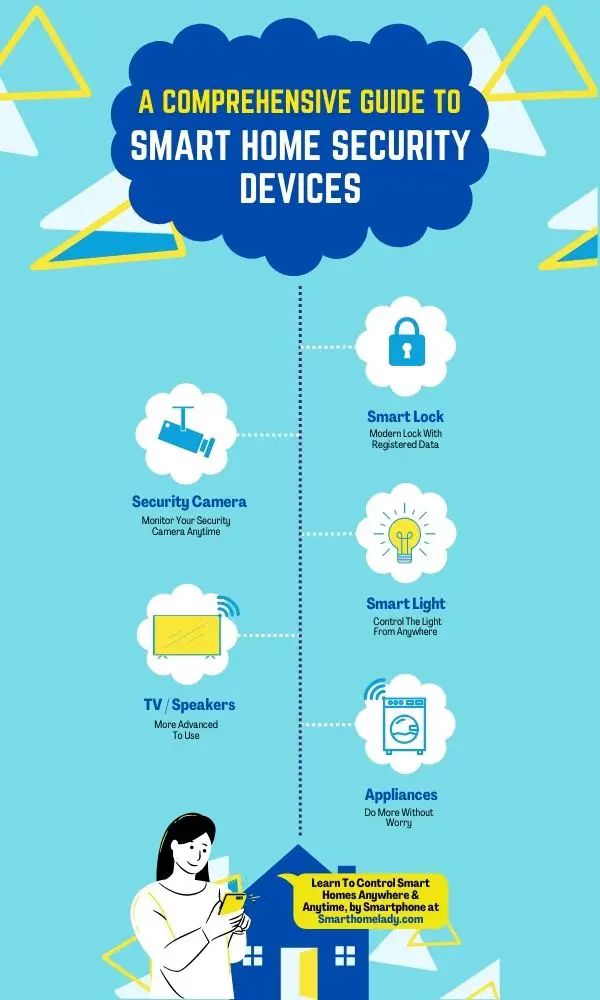
Contents
- 1 Smart Home Security Devices
- 2 Energy-Efficient Appliances
- 3 Voice-Activated Home Assistants
- 4 Benefits of Smart Home Security Devices
- 5 Top Smart Home Security Devices
- 6 Conclusion
Smart Home Security Devices
Smart home devices are all the rage in the USA. As of 2023, a whopping 60.4 million households are using these gadgets regularly (meaning at least once a month).
That’s a 3% increase from the previous year when 57.4 million households had smart devices in their homes. And on average, there are around 8 smart devices per household in the USA.
But wait, there’s more. By 2025, it’s predicted that over 57% of households in the USA will have a smart home device. That’s a lot of people enjoying the convenience and ease of using these devices.
And when it comes to security devices in particular, 12% of households have multiple smart devices like cameras, sensors, and video doorbells.
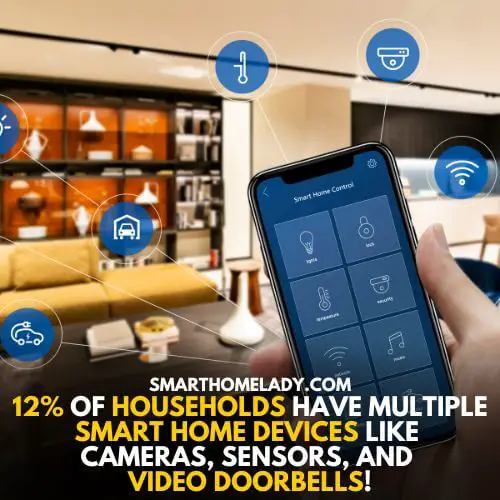
These statistics clearly show the trend that Smart home devices are becoming increasingly popular in the USA, especially those used to keep our homes safe and secure.
There are a wide variety of security devices available for smart homes today. These range from simple door sensors that alert you if someone enters your home without permission to sophisticated surveillance systems that use artificial intelligence algorithms to detect suspicious behavior.
Some devices can even be integrated with existing smart home platforms like Amazon Alexa or Google Home, allowing you to control them with just your voice.
Let’s take a look at these security devices.
1. Video Surveillance By Smart Security Cameras
As a security devices expert for smart homes, I know the importance of having video surveillance as part of your home security system. Video surveillance cameras can provide peace of mind and help deter criminal activity on your property.
However, with advancements in technology come privacy concerns that must be addressed. One concern is cloud storage options for recorded footage from the cameras.
It’s important to choose a company that values your privacy and uses secure servers to store your data. You don’t want hackers or unauthorized users accessing your personal information.
Another feature to consider when choosing video surveillance cameras is remote access capabilities.
With this capability, you can view live footage or recordings from anywhere using an app on your smartphone or tablet. This can be especially helpful if you’re away from home and want to check on things.
Night vision technology is also an essential component of modern video surveillance cameras. Having clear visibility during nighttime hours ensures that any potential intruders are captured on camera regardless of lighting conditions.
Additionally, integration with other smart home devices allows for seamless control and monitoring of all aspects of your home security system.
Next up, let’s discuss different types of security and their benefits in protecting your home even further.
i. Indoor and Outdoor Security Cameras
If you’re looking to keep an eye on both the inside and outside of your property, don’t overlook the convenience and peace of mind that indoor and outdoor cameras can provide.
With advancements in technology, these cameras have become more accessible and user-friendly than ever before.
Here are some benefits to consider when investing in indoor and outdoor cameras for your smart home security system:
- Many cameras come with motion sensor technology that can detect movement and alert you via smartphone notifications.
- Most cameras offer live streaming capabilities to monitor your property in real time from anywhere.
- Outdoor cameras often come equipped with night vision capabilities, allowing you to see clearly even in low-light conditions.
- Some cameras also offer two-way audio communication, allowing you to communicate with anyone near the camera through a built-in speaker and microphone.
- Many indoor and outdoor cameras are designed for easy installation, making it simple to set up your own smart home security system without professional help.
By incorporating indoor and outdoor cameras into your smart home security system, you can have greater control over who enters your property while ensuring that any potential threats are detected as quickly as possible.
Whether you’re at home or away, these devices will give you added peace of mind knowing that everything is being monitored around the clock.
ii. Wired And Wireless Security Cameras
Wired security cameras are connected to a power source and the internet through an Ethernet cable. These cameras are reliable and typically offer better video quality than wireless cameras.
Additionally, wired cameras are less susceptible to interference from other wireless devices, making them more reliable for long-term use.
However, the installation process for wired cameras can be more complicated and require professional help.
Wireless security cameras, on the other hand, use Wi-Fi to connect to the internet and do not require any wires for installation. This makes them easy to install and move around the house as needed.
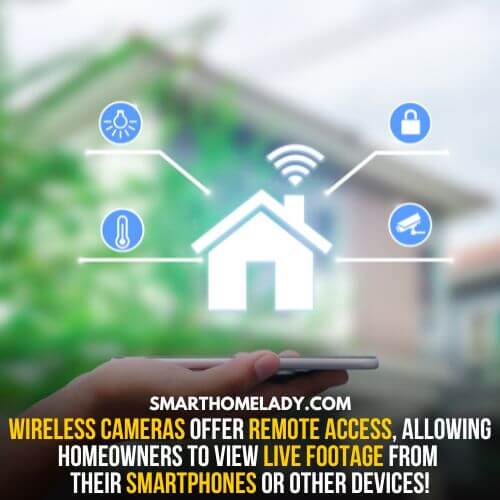
Wireless cameras also offer remote access, allowing homeowners to view live footage from their smartphones or other devices. However, wireless cameras may experience connection issues due to signal interference or weak Wi-Fi signals.
Both wired and wireless security cameras have their advantages and disadvantages. The choice between the two ultimately depends on the homeowner’s needs and preferences.
Regardless of the type of camera chosen, having a security camera system in place can provide peace of mind and added protection for smart homes.
2. Smart Door Locks
You can now easily see who’s at your door and unlock it without a key, due to these high-tech doorbells and locks.
With smart doorbells, you can get real-time video footage of anyone who approaches your home. You’ll be notified on your smartphone when someone rings the bell or even when motion is detected near your doorstep.
You can then see and talk to the person from wherever you are, whether you’re upstairs or miles away from home.
Smart locks allow you to lock and unlock your doors remotely using an app on your phone. No more fumbling for keys in the dark or worrying about lost keys – all you need is your smartphone.
The installation process for these devices is usually straightforward, but it’s worth noting that compatibility issues may arise with certain types of doors or existing security systems.
Be sure to do some research before purchasing a smart lock or doorbell to ensure that it will work seamlessly with your home’s setup.
Types of Smart Door Locks
When it comes to smart locks for doors, there are a few types to choose from; keyless entry, traditional keypads, and biometric scanners.
- Keyless entry locks allow for access to the home using a code.
- Traditional keypads require a physical key.
- Biometric scanners are opened using a fingerprint scan.
All of these smart locks provide a secure solution for your home, with features such as auto-locking, tamper alerts, and monitored access. Installation is simple and usually takes just a few minutes. Once installed, these locks provide an extra layer of security for your home.
Factors To Consider For Smart Door Lock
Looking for a smart lock that suits your home’s security needs can be overwhelming, especially when it comes to Smart Lock Types.
There are various types of smart locks available in the market today, and choosing one depends on your preferences and requirements.
However, before you get down to making a final decision, there are several factors you need to consider.
Smart lock installation is an essential factor you should keep in mind when selecting a smart lock type. Some smart locks require professional help with installation, while others come with easy-to-follow instructions for DIY enthusiasts.
Additionally, choose a smart lock compatible with your door; otherwise, it won’t work correctly. Also, maintenance is crucial because every device requires some level of upkeep to function optimally.
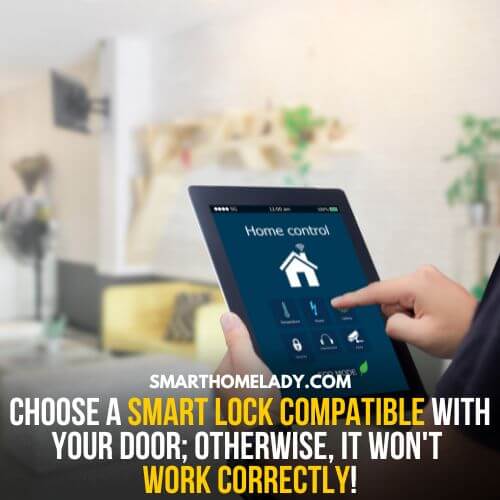
Security features are among the most important aspects when it comes to evaluating different Smart Lock Types. While all models offer unique capabilities and functionalities, make sure the one you select has remote access control via Wi-Fi or Bluetooth connection.
This feature allows you to monitor who enters your house, even when away from home, using your smartphone or tablet.
Security Features
When it comes to securing your home, smart locks for doors offer a convenient and reliable solution. However, with the increasing popularity of these devices, manufacturers have introduced various security features to enhance their functionality further.
As an expert in security devices for smart homes, I recommend considering mobile compatibility, cloud storage, facial recognition technology, and night vision capabilities when choosing a smart lock.
Mobile compatibility allows you to control your door lock remotely using your smartphone or tablet. This feature is particularly useful when you are away from home and want to ensure that your door is locked securely.
Additionally, some advanced models even provide real-time alerts whenever someone enters or exits your property.
Cloud storage enables homeowners to keep track of all activity at their doorstep by recording footage on cloud servers. In case of any suspicious activity like attempted break-ins or thefts, this stored footage can serve as crucial evidence while reporting the incident to law enforcement authorities.
Facial recognition technology and night vision capabilities enable your smart lock camera to identify individuals clearly in low-light conditions. With this feature, you can easily recognize who is entering/exiting through your door without additional lighting fixtures.
These features also improve overall safety and help prevent unauthorized access to your property.
While DIY installation may seem more cost-effective initially, investing in professional installation ensures optimal performance and reduces the risk of errors during setup.
By carefully analyzing all aspects before purchasing a smart lock for your home- including its security features -you can make sure that you choose the best option available within budget constraints.
Fingerprint Door Locks
Installing a Fingerprint Door Lock is easy! It takes just minutes to set up, and no special tools are needed. As far as design, it’s sleek and stylish and looks great with any type of door.
The technology is top-notch, with a high-tech biometric scanner that accurately reads fingerprints. It’s also incredibly secure, with features like auto-lock and anti-tampering that ensure your home is always safe.
So, a Fingerprint Door Lock is a great choice if you’re looking for a reliable security device for your smart home.
3. Smart Doorbells With Cameras
Smart doorbells with cameras have become increasingly popular as homeowners look for ways to improve their home security. These devices are designed to replace traditional doorbells, with the added benefit of a built-in camera that allows homeowners to see who is at the door before answering it.
Some models also come with two-way audio, allowing homeowners to communicate with visitors from smartphones or other mobile devices.

Many models come with motion detection sensors that alert homeowners when someone is at the door, even if they are not there to see it in person. This can be particularly useful for people who travel frequently or who have children at home alone during the day.
With a smart doorbell, homeowners can monitor their property from anywhere in the world, using their smartphone or other mobile device to view live footage or receive alerts when someone is at the door.
Installing a smart doorbell with a camera is relatively easy; all that’s needed is a power source and a spot to mount the unit. Privacy concerns are paramount for these devices, so users should make sure to follow manufacturers’ guidelines for keeping video footage secure.
Video quality is another important factor when considering a doorbell camera, as resolution and night vision capabilities can vary significantly.
I always recommend choosing a unit with HD resolution and infrared night vision for the best possible results. Additionally, users can add extra peace of mind by setting up motion-activation alerts or two-way audio communication.
Ultimately, ensuring your smart doorbell meets all your security needs is important.
4. Smart Lightbulbs
Smart lightbulbs offer a range of benefits beyond just lighting up your home. They can be programmed to turn on and off at specific times or when someone enters or exits a room.
This feature is especially useful if you’re away from home since it creates the illusion that someone is still there, which deters potential burglars.
Additionally, many smart bulbs come with remote control options to operate them even when you’re not at home.
One issue when installing smart lightbulbs may arise is compatibility issues between different brands and systems. Before purchasing any bulbs, make sure they are compatible with your existing system.
Another consideration is the installation process itself; some bulbs require professional installation, while others can be easily installed by the homeowner themselves.
When considering cost analysis, keep in mind that while these bulbs may initially seem more expensive than traditional ones, their energy efficiency and long lifespan mean that they will save you money in the long run.
Voice-Controlled Lights
Voice activation is a great way to control lighting in your home; it allows you to adjust the settings without ever having to leave your seat.
With voice control, you can easily dim the lights, turn them on and off, or switch to special lighting effects.
It’s a great way to save energy, too. Controlling lights with your voice also increases your home’s security, as you can adjust the lights remotely with your voice, even when you’re away.
Voice-controlled lights are very easy to customize and automate, so you can create the perfect lighting atmosphere for any occasion.
Lighting Control By Automatic Scheduling
Automated scheduling allows homeowners to set specific times for their lights to turn on or off, creating a more energy-efficient home while still maintaining a safe environment.
With remote access capabilities, users can control their lights from anywhere using their smartphone or tablet. This feature also provides an added layer of security by allowing homeowners to make it look like someone is at home even when they’re away.
Voice integration takes things one step further by allowing users to control their lights with simple voice commands.
Smart assistants such as Amazon Alexa or Google Assistant can be integrated with most lighting systems, making it possible for homeowners to adjust the brightness or color temperature without ever lifting a finger.
Energy Efficiency Of Smart LightBulbs
As a security devices expert for smart homes, I also want to highlight the benefits of voice-controlled lights when it comes to energy efficiency.
By integrating these systems with other green technology like smart thermostats and renewable energy sources, homeowners can make their homes more sustainable and reduce their carbon footprint.
For those looking for even more energy-saving tips, customization options provide opportunities for unique settings that cater specifically to individual preferences and routines.
For example, some prefer warmer tones in the evening, while others find cooler temperatures more conducive to concentration during work hours.
With voice-controlled lighting systems, homeowners have greater flexibility in tailoring their environment to suit their needs while still promoting sustainable living practices.
5. Motion Activated Alarms
Motion-activated alarms are a popular feature in smart home security systems. These alarms are designed to detect movement in specific areas and trigger an alert or alarm if motion is detected.
They are ideal for monitoring entryways, outdoor spaces, and other areas of the home that are vulnerable to intruders.
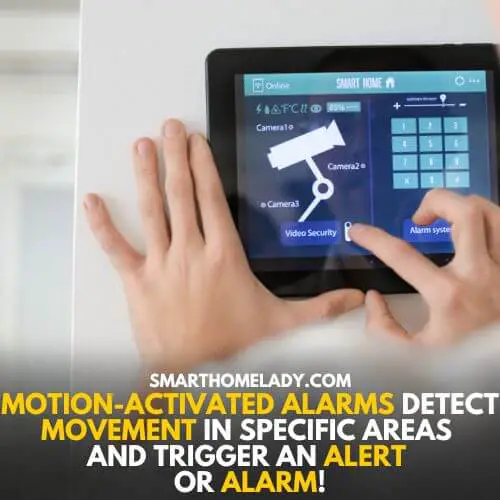
Motion-activated alarms can be customized to suit a homeowner’s specific needs, with settings that can be adjusted to suit the level of sensitivity desired.
Some systems even allow for remote monitoring and control, allowing homeowners to receive alerts and view footage from their smartphones or tablet.
In addition to their security benefits, motion-activated alarms can also be used to improve energy efficiency and reduce utility costs.
For example, they can be programmed to turn off lights and electronics when no motion is detected in a room or to adjust the temperature settings in response to occupancy. This can help homeowners save money on their energy bills and reduce their carbon footprint.
6. Window And Door Sensors
Installing window and door sensors is a great way to enhance the security of your smart home. They’re easy to install and come in various types and sizes to suit your needs.
Some of the main types of sensors are magnetic, infrared, and ultrasonic. They offer a variety of benefits, such as being able to detect when windows or doors are opened or closed, so you can be alerted if there’s any unusual activity in your home.
They can also be used to control lighting and heating and enable voice control and automated routines.
7. CO And Smoke Detectors
Carbon Monoxide (CO) Detection and Fire Prevention are vital elements of any smart home protection system.
Safety devices such as CO detectors and smoke alarms can save lives by alerting homeowners to potential dangers within their homes.
These alarm systems have advanced significantly over the years, with many now integrating with smart home technology for even greater convenience and security.
Alarm Systems are effective tools in keeping our homes safe from unexpected events like fire outbreaks or carbon monoxide poisoning.
Modern models include features like voice alerts, smartphone integration, and long-lasting batteries to ensure maximum performance during emergencies.
With these innovative solutions available on the market today, there has never been a better time to invest in this crucial aspect of home protection.
8. Burglar Alarms
Burglar alarms are a crucial component of any smart home security system. They serve as the first line of defense against intruders and can alert homeowners to potential break-ins. However, false alarms can be a major annoyance for both homeowners and their neighbors.
To prevent false alarms, it is important to use prevention techniques such as properly maintaining alarm systems and avoiding common mistakes like leaving windows open or pets in motion sensor areas.
Consequences of repeated false alarms may include fines from local authorities.
When considering burglar alarms, one must choose between wired and wireless options. Wired systems offer reliable connectivity but require professional installation, while wireless systems are easier to install but may have connectivity issues.
It is also worth noting that some insurance companies provide discounts on premiums for homes with professionally installed wired systems.
Alarm monitoring services offer additional protection by providing 24/7 surveillance and immediate response to emergencies. However, these services are costly and may not be necessary for all households.
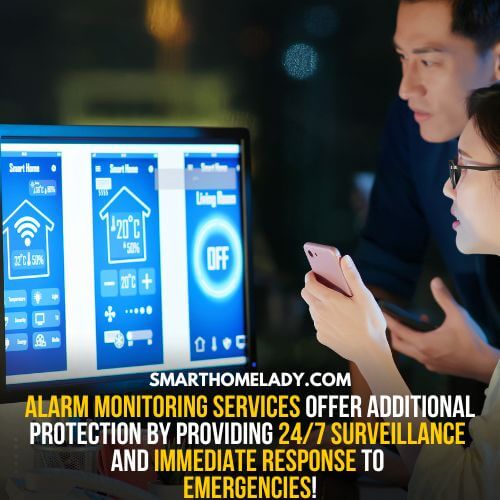
DIY burglar alarm kits are available for those who prefer a more hands-on approach to installation. Recommended products include SimpliSafe Home Security Systems and Ring Alarm.
9. Smart Thermostats
I understand the importance of maintaining a comfortable temperature in your home, so I recommend investing in smart thermostats. These devices offer efficient programming options that allow you to set schedules and desired temperatures for different times of the day.
With remote control capabilities, you can easily adjust the thermostat from anywhere using your smartphone or tablet. Smart thermostats also have learning capability, meaning they adapt to your daily routine and preferences over time.
They use this data to optimize energy usage and save you money on heating and cooling costs.
Additionally, these devices integrate with mobile apps that provide real-time updates on your home’s temperature and energy consumption.
By incorporating smart thermostats into your security system, you can achieve optimal comfort while simultaneously reducing energy waste.
Energy-Efficient Appliances
As a security devices expert for smart homes, I highly recommend investing in eco-friendly devices to promote sustainable living and reduce your carbon footprint.
Here are three energy-saving tips when it comes to selecting energy-efficient appliances for your smart home automation:
- Look for appliances with Energy Star ratings – this indicates that they meet strict efficiency guidelines set by the U.S. Environmental Protection Agency.
- Choose appliances with features such as auto shut-off or sleep mode when not in use to conserve even more energy.
- Consider purchasing smaller appliances, which generally consume less electricity overall than larger ones.
By incorporating green technology into your home, you’ll not only save money on utility bills but also contribute towards a healthier planet. Sustainable living is no longer just an option; it’s now a necessity if we want to preserve our planet for future generations.
Voice-Activated Home Assistants
Voice-activated home assistants such as Alexa and Google Home have become increasingly popular in recent years. These devices offer a convenient way for users to control their smart homes, play music, set reminders, and access information with just a few simple voice commands.
By using natural language processing and machine learning, these assistants are able to understand and respond to a wide range of requests, making them a valuable addition to any home.
One of the key benefits of voice-activated home assistants is their ability to integrate with a wide range of other smart devices, such as smart thermostats, lights, and security systems.
This allows users to control their entire home with just their voice, creating a more seamless and intuitive experience.
Additionally, these devices are constantly evolving, with new features and capabilities being added all the time.
As the technology continues to improve, voice-activated home assistants are likely to become even more ubiquitous, eventually becoming a standard feature in most homes.
However, they also come with their fair share of privacy concerns. One major issue is accidental activation.
If the device’s wake word is similar to common words or phrases used in everyday conversation, it may activate unintentionally. This could result in private conversations being recorded without the user’s knowledge or consent.
To mitigate this risk, users should be mindful of where they place their voice-activated assistants and consider adjusting the sensitivity level if necessary.
Another concern is voice recognition accuracy. While these devices have come a long way in terms of accurately understanding and interpreting spoken commands, there is still room for error.
Users may find themselves having to repeat commands multiple times or experiencing frustration when the device fails to recognize their voice altogether.
Additionally, integration with other smart devices can further complicate matters by introducing additional variables that affect overall performance.
Despite these potential security vulnerabilities, Voice-Activated Home Assistants remain attractive for many homeowners looking to simplify their lives through automation technology.
As always, weighing the benefits against the risks before investing in any new technology product for your home environment is important.
Benefits of Smart Home Security Devices
Enhanced home security is one of the most significant benefits of smart home security devices. You can monitor your property from anywhere and receive alerts if there’s any unusual activity.
With a smart home security system in place, you will have peace of mind knowing that your loved ones and property are safe at all times.
Additionally, these devices are cost-effective solutions as they can help reduce insurance premiums and prevent potential losses due to break-ins or thefts.
1. Enhanced Home Security
With the rise of home automation, there are now more options than ever before for enhancing your home security. Smart home security devices offer a range of benefits that traditional security systems can’t match.
Here are three ways in which smart home security devices can enhance your home security:
- Real-time monitoring: Smart cameras and motion sensors allow you to monitor your property 24/7 from anywhere in the world using your smartphone or other internet-connected device. This means that you can keep an eye on things even when you’re not at home and receive instant alerts if any unusual activity is detected.
- Enhanced access control: Smart locks and doorbells with video capabilities give you greater control over who enters your property, allowing you to remotely lock/unlock doors and see who’s at the front door before letting them in.
- Privacy concerns: While smart home security devices offer many benefits, there are also concerns about privacy and data collection. It’s important to carefully read the privacy policies of any device you plan to use so that you understand how your data is being collected, stored, and used by the manufacturer.
2. Peace of Mind
Smart home security devices not only provide a sense of security but also a sense of peace of mind to homeowners. They offer a wide range of features like motion sensors, door and window sensors, cameras, and alarms that can be monitored and controlled remotely from a smartphone or tablet.
With these devices, homeowners can keep an eye on their homes even when they are away, ensuring that their homes are safe and secure at all times.
Moreover, smart security devices are equipped with advanced analytics that can detect unusual activity and alert homeowners in real-time. This means that homeowners can take immediate action in case of any intrusion or breach.
3. Cost-Effective Solutions
If you’re on a tight budget but still want to keep your house safe, many affordable solutions are available that won’t break the bank.
One of the most cost-effective options is to invest in a DIY installation smart home security device with wireless connectivity.

These devices allow you to monitor your home from anywhere using your smartphone or tablet and can be easily installed without professional help.
To make the most out of your budget, here are some tips to consider when shopping for a smart home security device:
- Look for devices with built-in cameras that offer motion detection and night vision capabilities.
- Choose devices that have an easy-to-use app interface, so you don’t need technical expertise to set them up.
- Consider purchasing a device with multiple sensors (such as smoke detectors, carbon monoxide detectors, and water leak detectors) for added peace of mind.
By taking advantage of these affordable smart home security solutions, you can rest assured that your home is protected without spending a fortune.
4. Integration with Other Devices
One of the significant advantages of having a smart home is the ability to connect and control all of your devices through one central hub.
This means that your security system can communicate with other devices in your home, such as voice assistants and smart thermostats, to provide an even more seamless experience.
For example, imagine coming home from work on a hot summer day. As you approach your house, your security camera detects motion and sends a notification to your phone.
You unlock the door using your smartphone and walk into a cool, comfortable environment due to the integration between your security system and smart thermostat.
This level of convenience and automation is made possible by the compatibility between different devices in your smart home ecosystem.
Few Examples of How Different Types of Devices can be Integrated:
| Device Type | Integration Capabilities |
|---|---|
| Voice Assistants (e.g., Amazon Alexa) | Arm/disarm security system using voice commands |
| Receive alerts from security cameras via audio notifications. | |
| Control smart locks with voice commands. | |
| Smart Thermostats (e.g., Nest) | Adjust temperature settings based on whether or not you’re at home according to the security system. |
| Send alerts when unusual temperature fluctuations are detected. |
Overall, integrating different types of devices in your smart home can create a more streamlined and efficient experience.
By connecting your security system with other devices like voice assistants and thermostats, you can have greater control over various aspects of your home while also enhancing safety and peace of mind.
Top Smart Home Security Devices
| Device Type | Popular Options | Key Features |
| Smart Locks | August Smart Lock, Schlage Encode | Keyless entry, remote access, guest access |
| Security Cameras | Arlo Pro 4, Nest Cam IQ | High-resolution video, night vision, motion detection |
| Video Doorbells | Ring Video Doorbell Pro, Nest Hello | Two-way audio, motion detection, HD video |
| Motion Sensors | Philips Hue Motion Sensor, SmartThings | Customizable sensitivity, notifications, smart home integration |
| Window & Door Sensors | SimpliSafe Entry Sensor, Ecolink | Instant alerts, easy installation, tamper protection |
| Smart Alarms | Nest Secure, SimpliSafe | Customizable, professional monitoring, easy installation |
| Smoke & CO Detectors | Nest Protect, First Alert Onelink | Voice alerts, smartphone notifications, home automation |
| Smart Lighting | Philips Hue, LIFX | Remote control, energy savings, customizable scenes |
Conclusion
With so many options available on the market today, it can be overwhelming to choose which devices are best for your home.
However, by considering your specific needs and budget, you can easily select a combination of smart doorbells and locks, indoor and outdoor cameras, smart lighting and alarms, smart smoke detectors, and carbon monoxide detectors that will keep you feeling safe and secure.
The benefits of investing in these devices are numerous – peace of mind knowing that your home is protected while you’re away or asleep; the ability to monitor your property from anywhere using a smartphone or tablet; early warning systems for fires or other emergencies; and even savings on homeowners insurance premiums.
References
- Oberlo.com
- Statista.com
- Hippo.com – Smart Home Statistics
- Enterprise Apps Today


